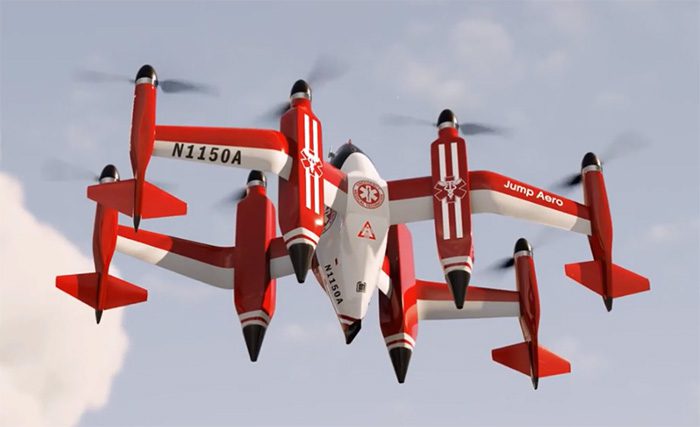The JA1 Pulse vertical take-off and landing aircraft is equipped with 8 electric propellers, capable of quickly transporting rescue personnel to patients in need.
Simulation of the JA1 Pulse ambulance aircraft in action. (Video: Jump Aero)
American company Jump Aero has unveiled the design of the JA1 Pulse, a electric vertical take-off and landing (eVTOL) vehicle intended to swiftly transport rescue personnel to emergency locations, as reported by New Atlas on September 7. The JA1 Pulse has received pre-orders, but Jump Aero has not yet announced the official operational date for this aircraft model.
The JA1 Pulse features a tail-sitter design, meaning that when it is on the ground, the aircraft “sits” on its tail, with the nose and 8 propellers directed upwards. It takes off vertically like a helicopter but pivots horizontally to fly forward once it reaches an appropriate altitude. The structure between the propellers then functions as the wings of a biplane, allowing for faster and more efficient forward flight compared to traditional helicopter or multi-rotor designs.
A pilot who also serves as a rescue worker will stand while the JA1 Pulse is on the ground and then transition to a prone position as the aircraft moves forward. In both positions, the pilot can observe the front and below through windows located at the nose and belly of the aircraft.
The control system is simplified, meaning that no extensive training is required to operate the JA1 Pulse. Additionally, there are no features on the eVTOL that would pose a catastrophic risk in case of failure. If the aircraft cannot remain airborne, the pilot can deploy a parachute.

JA1 Pulse is not designed to replace traditional ambulances.
The JA1 Pulse is expected to have a maximum speed of 463 km/h, capable of carrying equipment or a pilot weighing up to 150 kg, and can reach any location within a 50 km range in just 8 minutes. This aircraft can land on slopes of up to 10 degrees and is compact enough to be transported by flatbed truck without disassembly. Each propeller is powered by an 11 kWh battery, which can be charged simultaneously through a single port.
As it is not intended for patient transport, the JA1 Pulse is not meant to replace traditional ambulances. Instead, during emergencies, both the aircraft and ambulances will be dispatched to respond. The aircraft can arrive at the scene much earlier. At that point, the pilot-rescue worker will manage the initial response with the medical equipment onboard. When the ambulance arrives, the staff on the vehicle will take over, allowing the JA1 Pulse to immediately transition to another mission.


















































